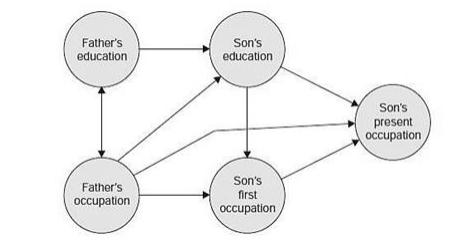The term ‗path analysis‘ was first introduced by the biologist Sewall Wright in 1934 in connection with decomposing the total correlation between any two variables in a causal system. The technique of path analysis is based on a series of multiple regression analyses with the added assumption of causal relationship between independent and dependent variables. This technique lays relatively heavier emphasis on the heuristic use of visual diagram, technically described as a path diagram. An illustrative path diagram showing interrelationships between Fathers‘ education, Fathers‘ occupation, Sons‘ education, Sons‘ first and Sons‘ present occupation can be shown in the diagram below.
Path analysis makes use of standardized partial regression coefficients (known as beta weights) as effect coefficients. In linear additive effects are assumed, then through path analysis a simple set of equations can be built up showing how each variable depends on preceding variables. ―The main principle of path analysis is that any correlation coefficient between two variables, or a gross or overall measure of empirical relationship can be decomposed into a series of parts:
separate paths of influence leading through chronologically intermediate variable to which both the correlated variables have links.‖
The merit of path analysis in comparison to correlational analysis is that it makes possible the assessment of the relative influence of each antecedent or explanatory variable on the consequent or criterion variables by first making explicit the assumptions underlying the causal connections and then by elucidating the indirect effect of the explanatory variables.

The use of the path analysis technique requires the assumption that there are linear additives, a symmetric relationships among a set of variables which can be measured at least on a quasi interval scale. Each dependent variable is regarded as determined by the variables preceding it in the path diagram, and a residual variable, defined as uncorrelated with the other variables, is postulated to account for the unexplained portion of the variance in the dependent variable. The determining variables are assumed for the analysis to be given (exogenous in the model).‖
